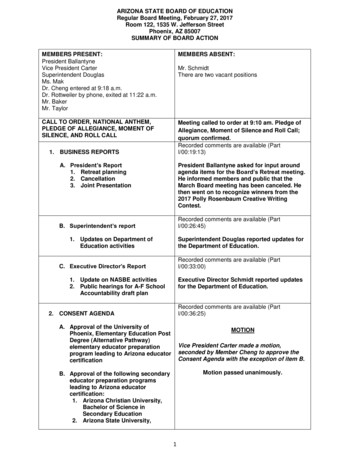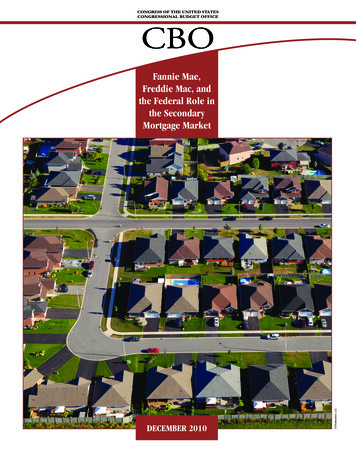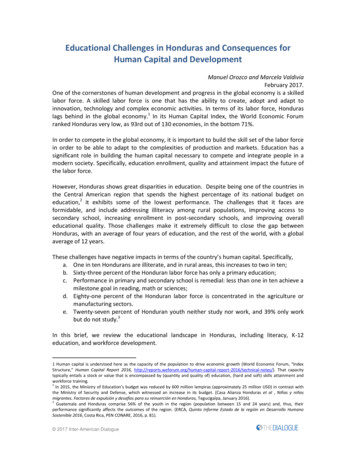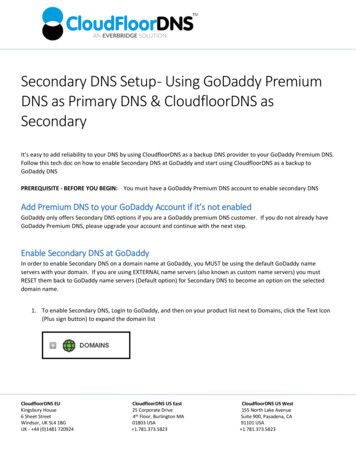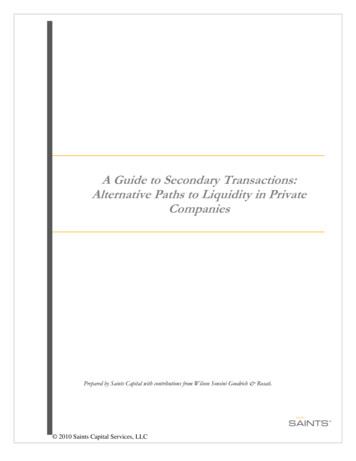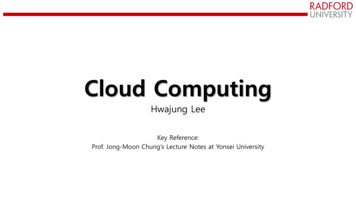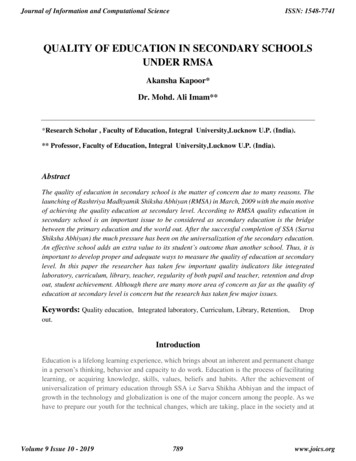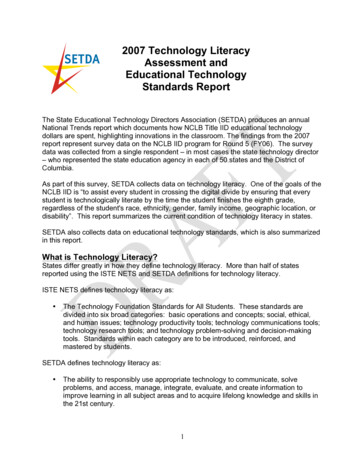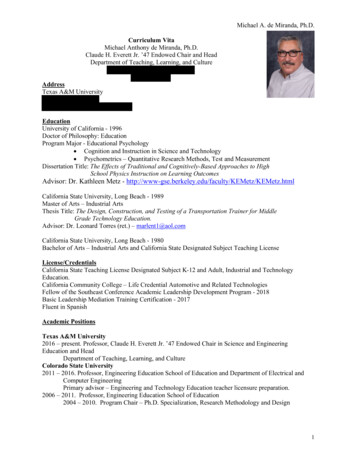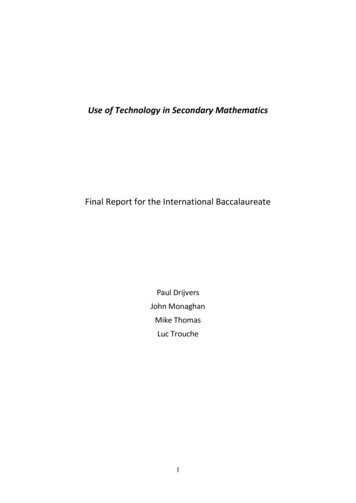
Transcription
Use of Technology in Secondary MathematicsFinal Report for the International BaccalaureatePaul DrijversJohn MonaghanMike ThomasLuc Trouche1
ContentsIntroduction2Summary4Scope of Work 1: Literature review7Scope of Work 2: Comparative document analysis25Addressing the research questions34AppendicesAppendix 1: References for Scope of Work 143Appendix 2: Scope of Work 2, questionnaire57Appendix 3: Scope of Work 2, national descriptions602
IntroductionThe International Baccalaureate (IB) commissioned us to write a report to:provide insights into the use and integration of technology into curriculum,classroom practice and impact on learning in secondary mathematics courses andwill inform possible direction and focus for the coming curriculum review of IBDPmathematicsThe study aims are:Aim 1. Explore types of technology used in mathematics curricula for students aged 1619 years old in different educational systems (within a country andinternationally);Aim 2. Examine approaches and strategies to technology integration in curriculumdesign, pedagogy and assessment;Aim 3. Indicate issues involved in the use of technology in mathematics courses;Aim 4. Identify factors increasing the effectiveness of technology implementation inclassroom practice;Aim 5. Analyse the effects of using and integrating different types of technology on thedevelopment of mathematical skills and academic achievement in mathematics.The scope of work (SoW) was to be two-fold:SoW 1. A literature review on a comprehensive range of theoretical and empiricalstudies in the use of technology in senior secondary mathematics educationworldwide.SoW 2. Analysis of IB documentation including IB official curriculum documents,teacher support materials, workshop resources.Discussions between the research team and key IB personnel led to a review of SoW 2:to compare the IB’s intended (reflected in the official documentation) andimplemented 16-19 mathematics curricula (reflected through personalcommunication) with the intended and implemented curricula in other countries3
Research QuestionsThe IB stated:We hope to capitalise on the knowledge and interests of our research partner andthus recommend that the researchers bring their own strengths and experience tothe design of the study and research questions. Research questions will address butare not limited to the following:RQ 1. What are trends and approaches to technology in secondary mathematics educationworldwide? What are differences, commonalities and variables in relation to (forexample):a) Types of technology usedb) Technology integration in curriculumc) Learning objectives and expected outcomesd) Pedagogy and classroom practicee) Assessmentf) OthersRQ 2. What guidance is given on the use and integration of technology in teaching andlearning mathematics in various (international) education curricula? What areemergent themes and patterns in relation to frequency, tools and applications,pedagogical strategies and so forth?RQ 3. What are the issues, enablers and challenges of using technology in the teaching andlearning of mathematics in both IB and non-IB school contexts?RQ 4. What is the impact of using particular technologies on the development ofmathematical skills and academic achievement in mathematics in both IB and non-IBschool contexts?RQ 5. To what extent do objectives, approaches to technology integration, pedagogicalstrategies and learning practices in DP mathematics courses reflect thecontemporary trends, initiatives and strategies in the use of technology in secondarymathematics education worldwide?We found that we could work with the IB’s research questions.In the following we first present a summary of our work. We then present our work forScope of Work 1 and 2. We then address the research questions. Three appendices,References for Scope of Work 1and Scope of Work 2, national descriptions, complement thisreport.4
SummaryThis section summarises the Report. It does this in two parts: Findings; matters for IBconsideration. This summary aims at plain English and does not make links to subsequentsections. The term ‘six countries’ refers to document analysis of 16-19 academic streammathematics in Australia, England, France, The Netherlands, New Zealand and Singapore.The term ‘technology’ in this summary refers to advanced (i.e. more than a scientificcalculator) digital technology.FindingsThe findings are presented in six sections which start with the intended curriculum and endswith the intended assessment. The four intermediate parts deal with aspects of theimplemented curriculum: types of technology used; learning; student skills andcompetences; pedagogy.CurriculumCurricula documents for academic stream mathematics from the IB and all the six countriesmention technology as an explicit element in the mathematics curricula. There has beendebate on the integration of technology into mathematics in some of the documentsexamined. Reference to the use of technology in documents is often general, for example,“Use technology to present and communicate mathematical ideas” but is sometimesspecific, for example: “In appropriate situations, the candidate can set up an integral, calculate its exactvalue and approximate it using ICT”“Use a spreadsheet or an equivalent technology to construct a table of values from aformula, including two-by-two tables for formulas with two variable quantities”Types of technology usedThe technology most commonly referenced in the documents from the IB and all the sixcountries is the graphic display calculator (GDC). In two countries calculators with symbolicmanipulation facilities are used/referred to and there is some experimentation with the useof such calculators in some other countries. In mathematics lessons computer labs are notuncommon and there is a rise in class use of laptop/tablet computers in recent years. Theuse of video clips and online courses is also increasing. The availability and use of interactivewhite boards by teachers varies, from regular to occasional, over the six countries. Teachersin all countries use internet resources to find and share content; in some countries this ismanaged in an organised way 1.LearningThe quality of student learning with technology is difficult to measure due, in part, todifferences amongst mathematics educators: as to what ‘learning’ means; between thosewho see technology as a medium to communicate mathematics to students and those who1See Scope of Work 2 for details.5
see technology as a means for students to express mathematical relationships. However,reviews of research report qualified success. One review of graphic calculator use statesthey can aid students’ understanding of concepts. A second review of all technologyreported that technology is making a modest difference in learning of mathematics.Research consistently shows that the organisation of classroom resources is a crucial factorand that student learning is sensitive to small differences in the way computer-based tasks,paper-and-pen work and whole-class teaching are intertwined.Student skills and competencesTechnology introduces new skills that students must master: setting up suitable scales ongraphic calculator; making mathematical rather than simply visual links between geometricobjects in geometry software. Apart from skills in using technology students need to acquireskills in interpreting displays and to make connections between numeric, symbolic andgraphic/geometric mathematical representations. Without these skills students may, forexample, accept a graphic image uncritically, without attempting to relate it to othersymbolic or numerical information.PedagogyThe teacher is key to the successful use of technology in the mathematics classroom butincorporating technology into teaching remains a challenge for many teachers and thedegree and type of technology used in the classroom is variable. Reasons for this includeteachers’ proficiencies in mathematics and their perceptions of the nature of mathematicalknowledge and how it should be learned; and teachers’ understandings of the principles,conventions and techniques required to teach mathematics with technology. In addition toattending training courses, collaborative work to develop resources and classroomapproaches are important as such work aids teachers’ critical reflection on their practiceand their professional development.AssessmentThe IB and all the six countries have high stakes examinations which permit the use oftechnology in at least some of the examination papers. All allow graphic calculators andsome allow calculators with symbolic manipulation. None allow internet use or printing.There are differences with regard to: marking and grading procedures; examinations beingcentrally or school set; lists of approved technology (or not); the need to clear memory (ornot); and whether questions are set which expect or simply allow the use of technology.Research literature on assessment with technology is sparse, particularly on formativeassessment. Studies on e-assessment are in their infancy but point to the need for principlesto avoid simply examining what current technology enables. Studies on summativeassessment point to problems: focusing on a single tool with the expectation that thestudent will rise to the use of this tool; trivialising routine questions and thus disadvantaginglower attaining students; and the difficulty of designing ‘good’ technology-tasks. A studywhich included IB examinations concluded that there have not been major changes in theexamination questions due to technology.6
Matters for IB considerationOur research into use of technology in 16-19 academic stream mathematics leads us to twosets of matters for IB consideration in their coming curriculum review of DP mathematics:tools and resources; and pedagogic practices and professional development.Tools and resourcesWhilst the IB was innovative in the past in embracing graphic calculator use, DPmathematics does, perhaps, place too much emphasis on this single tool. Coupled with this,tool use should be seen in the context of the resources available in classrooms. A challengefor the IB is to consider a wide range of tools and resources available for DP mathematics:traditional mathematical tools; techno-mathematical tools with capabilities for algebra,geometry and calculus; traditional resources such as textbooks; and digital/internet-basedresources for teaching and learning 2.There are many sub-challenges within this challenge. The use of tools with capabilities foralgebra, geometry and calculus would require serious consideration of the place oftechniques and concepts in DP mathematics and it may be useful to consider parallel byhand/by-technology DP courses so that teachers may come on board when they areconfident 3. Linking graphic calculator use to the full range of classroom resources wouldinclude reviewing the tasks teachers offer to students and this may lead the IB to reconsiderwhether textbooks should be included in IB documentation. Consideration of internet-basedresources may lead to on-line communities of teachers and students and the challenge offacilitating these communities.Whilst IB staff who are not classroom-based have an obvious role in taking these challengesforward, it is important that teachers are a full part of finding solutions to these challenges,which leads us on to the next set of matters for IB consideration.Pedagogic practices and professional developmentThe quality of IB teacher support material and workshops appears very high but the IBshould consider whether this is sufficient for teacher development for the integration oftechnology into DP mathematics. The success of designs for such integration requires accessto technology, the development of technological knowledge and assisting teachers todevelop modes of organising classrooms for student learning. Our review of research pointsto the benefits of teachers’ collaborative work in this endeavour.A model of professional development that has had some success is to structure it around asupportive community of inquiry on everyday classroom practice where all participants areco-learners and knowledge, classroom practices and resources are developed, shared andevaluated by the group. Given the geographical distance between IB schools on-linecommunities can be set up to facilitate such communities of inquiry.23See Scope of Work 1, section 1(b) for details.See Scope of Work 1, section 3(a) for details.7
Scope of Work 1: Literature ReviewMethodIn this review we made a decision to concentrate on papers written from the years 2000 to2014 (exceptions were made for key papers) from journals rated as A* and A (and somerated as B) in a recent European rating of mathematics education journals (seehttp://www.mathematik.uni-dortmund.de/ erme/). The journals are: Educational Studies in MathematicsJournal of Mathematical BehaviorJournal for Research in Mathematics EducationMathematical Thinking and LearningMathematics Education Research JournalRecherches en Didactique des MathématiquesResearch in Mathematics EducationZDM: The International Journal on Mathematics EducationWe considered every paper in these journals for 2000 – 2014 and included all papers in ourreview that deal with technology which impacts in some way on 16-19 mathematics. Somepapers were included which were not specifically focused on but were felt to impact on 1619 mathematics with technology. Papers focussing exclusively on elementary mathematicswith technology were excluded from our review.In addition we looked at a number of important books as well as adding relevant papers thatwere known to us, or written by us. These included:Two International Handbooks of Mathematics Education:Bishop, A.J., Clements, M.A., Keitel, C., Kilpatrick, J. & Leung, F.K.S. (Eds.) (2003).Second international handbook of mathematics education. Dordrecht: KluwerAcademic Publishers.Bishop, A.J., Clements, M.A., Keitel, C., Kilpatrick, J. & Leung, F.K.S. (Eds.) (2013).Third international handbook of mathematics education. New York: Springer.Two books taking a general look at ICT integration in mathematics education:Guin, D., Ruthven, K. &Trouche, L. (Eds.) (2005), The didactical challenge of symboliccalculators: turning a computational device into a mathematical instrument.Gueudet, G., Pepin, B. &Trouche, L. (Eds.) (2012), From text to ‘lived’ resources:Mathematics curriculum materials and teacher development. New York:Springer.The 17th ICMI Study:Hoyles, C. &Lagrange, J.-B. (Eds.). (2010). Mathematical education and digitaltechnologies: Rethinking the terrain. New York: Springer.A book on teacher use of ICT:Clark-Wilson, A. Sinclair, N. & Robutti, O. (Eds.) (2014). The mathematics teacher inthe digital era. Dordrecht: Springer.8
The references are listed in the appendix for SoW 1 as is a bibliography that includes papersnot included in this review but which may be useful.The structure of the literature review is as follows:1. Teacher Issues and Technology Usea)b)c)d)e)Some Theoretical ConsiderationsApplications of the Theory to Classroom PracticeAffordances and Constraints in Teaching with TechnologyProfessional Development of TeachersEmerging Practice: Challenges and Implications for Curriculum Change2. Student Issues and Technology Usea) Student Learning Outcomesb) Examples of Technology Use and Specific Curriculum Areasi. Tasksii. Geometryiii. Statisticsc) Student and Teacher Interactionsd) Classroom Organisation for Student Learninge) Emerging Practice, Challenges and Implications for Curriculum Change3. Technology and Assessmenta) Formative and Summative Assessmentb) Emerging Practice, Challenges and Implications for Curriculum Change4. Some Implications and Predictions Related to Curriculum ChangeFindings1. Teacher Issues and Technology Usea) Some Theoretical ConsiderationsThere have been a number of theoretical approaches applied to issues surroundingtechnology use in the secondary mathematics classroom and the last decade has seenefforts aimed at using these frameworks to provide different, complementary views of thesame subject. For example, Lagrange et al. (2003), through a review of 800 articles,distinguished seven dimensions related to ICT use in mathematics classrooms: integration,epistemological-semiotic, cognitive, institutional, instrumental, situational and the teacherdimension. While this last dimension appears to have been quite neglected during the years1990-2000, it has increasingly been taken into account in the last decade, including a recent9
book (Clark-Wilson, Robutti & Sinclair, 2014) devoted to the mathematics teacher in thedigital era. In addition, Drijvers et al. (2010), have suggested the need for an integrativeframework in which considerations of didactical functionalities play an essential role,combining the three major dimensions of tool features, educational goals and associatedpotential of the tool and modalities of use in a teaching/learning process.While it is clear that the role of the teacher is a key to the successful use of digitaltechnology in the mathematics classroom, incorporating technology into teaching remains achallenge for many teachers and they need to be well prepared (Zbiek & Hollebrands, 2008).Hoyles et al. (2010) provide evidence for the critical role of teacher: as a facilitator whomaintained and supported the interaction, as a gatherer, making visible on a commonworkspace (the screen, for example) students’ production and as a mechanism fordiscussion; validating what did and did not make sense in terms of knowledge building.Some of the intrinsic factors contributing to the challenge facing teachers are theirorientations (Schoenfeld, 2011); their instrumental genesis (Artigue, 2002; Guin & Trouche,1999; Rabardel, 1995; Vérillon & Rabardel, 1995) and orchestrations (Trouche, 2005c);Drijvers & Trouche 2008); their perception of the nature of mathematical knowledge andhow it should be learned (Zbiek & Hollebrands, 2008); their mathematical contentknowledge; and their mathematical knowledge for teaching (MKT – Ball, Hill &Bass, 2005;Hill & Ball, 2004; Zbiek, Heid, Blume & Dick, 2007). The idea of MKT covers appropriatestructuring of content and relevant classroom discourse and activities to form didacticalsituations. Thus, it is not surprising that, while many mathematics teachers claim to supportthe use of technology in their teaching (Forgasz, 2006a; Thomas, 2006), the degree and typeof use in the classroom remains variable (Ruthven & Hennessy, 2002; Zbiek & Hollebrands,2008).Two complementary frameworks that have merit in analysing factors that may influenceteacher use of technology and provide an indication of teacher readiness forimplementation of technology use, are Pedagogical Technology Knowledge (PTK) (Hong &Thomas, 2006; Thomas & Hong, 2005b) and the Technological Pedagogical ContentKnowledge (TPACK) (Mishra & Koehler, 2006; Koehler & Mishra, 2009). A critical review ofthe notion of TPACK, including an analysis of its affordances and constraints can be found inGraham (2011). Both of these frameworks build on pedagogical content knowledge (PCK) ofShulman (1986), by adding technology knowledge. In this aspect, PTK incorporates theprinciples, conventions and techniques required to teach mathematics through thetechnology. This includes the need to be a proficient user of the technology, but moreimportantly, to understand the principles and techniques required to build and managedidactical situations incorporating it and enable mathematical learning through thetechnology. According to Koehler and Mishra (2009, p. 64), the TPACK definition oftechnology knowledge is close to that of Fluency of Information Technology (FITness), asproposed by the Committee of Information Technology Literacy of the National ResearchCouncil (see Snyder et al., 1999). This requires that teachers understand informationtechnology broadly enough to apply it productively at work and in their everyday lives, torecognise when information technology can assist or impede the achievement of a goal andcontinually to adapt to changes in information technology.10
b) Applications of the Theory to Classroom PracticeIn addition to technology knowledge, PTK includes teacher orientations and goals(Schoenfeld, 2011), especially beliefs about the value of technology and the nature oflearning mathematical knowledge as well as crucial affective aspects, such as teacherconfidence (Thomas & Palmer, 2014). Although in general teachers may agree there arepotential benefits of technology for students' mathematics learning, many remain unsure orunconvinced about whether its use helps students to explore mathematical concepts orunfamiliar problems (Forgasz, 2002; Thomas, 2006; Goos & Bennison, 2008). That teacherbeliefs can inhibit technology use, was demonstrated by Zuber and Anderson (2012) in aone-to-one laptop programme. They report that a prevalent belief limiting laptop use is thatstudents only learn mathematics authentically using pen and paper. Further, cautiousAdopters and Non Adopters of technology expressed beliefs that laptops exacerbateclassroom management problems, especially for lower-achieving students. The study byLagrange and Dedeoglu (2009), in the context of “ordinary” classes, reveals a high level ofteacher expectation with regard to technology, but a quite low degree of integration. Theyanalyse this phenomenon as the co-existence of two worlds, the world of teacherexpectation and the world of technology potentialities. To establish links between these twoworlds requires encouraging teachers’ collective work and reflective practices.One useful way to reflect on the alignment of the teacher preparedness factors with theiractual classroom practice is that of instrumental orchestrations (see Drijvers & Trouche,2008 for the theoretical framework of instrumentation and orchestration and someconcrete examples), or the ways in which the teacher manages the changing classroomenvironment when technology is present. A primary goal of the orchestrations is to engagestudents in activity producing techniques with both epistemic value, providing knowledge ofthe mathematical object under study and ‘productive potential’ or pragmatic value (Artigue,2002). The classroom orchestrations appear as a response to both the proliferation andincreasing complexity of technological resources. The notion of orchestration itself evolves,from an individual and static conception (orchestrations of a mathematical situation seenthrough didactical configurations and exploitation modes of these configurations – Trouche2002, 2005c, 2005d, 2007) with a social perspective (orchestrations seen as the result ofteachers collaborative work – Hoyles et al., 2010) to a dynamic view (including the didacticalperformance, teachers’ adaptation on the fly – Drijvers et al., 2010 and teacher adaptationover time – Drijvers, 2012). Some researchers (e.g., Drijvers, Doorman, Boon, Reed &Gravemeijer, 2010; Drijvers, Tacoma, Besamusca, Doorman & Boon, 2013) have taken theframework of instrumental orchestration as a point of departure for categorising observedteaching practices. This results in a kind of (non-exhaustive and maybe tool, topic andculture dependent) taxonomy, depicted in the Figure below. The Figure provides anoverview of whole-class and individual orchestrations identified in the study; the middlearrows simply show correspondence between whole-class and individual orchestrations.11
Other analyses of factors influencing teacher implementation of a technology-richmathematics curriculum and practices include that by Assude et al. (2010, p. 406), whopropose a typology comprising: the social, political economical and cultural level; themathematical and epistemological level; the school and institutional level; the classroomand didactical level. Further, Ruthven (2012) identifies five key structuring features ofclassroom practice and shows how they relate to the constitution of digital tools andmaterials as classroom resources: working environment (physical surroundings wherelessons take place), resource system (collection of mathematical tools and materials inclassroom use), activity format (generic templates for action and interaction which framethe contributions of teacher and students to particular types of lesson segment), curriculumscript (evolving teacher knowledge gained in the course of her own experience of learningand teaching a given topic) and time economy (managing the physical time available forclassroom activity to be converted into a didactical time, measured in terms of advance ofknowledge). Finally, a web metaphor has been used to describe the new way of teachingmathematics in the digital era (Leguay, 2011).There appears to be a need for teachers to evolve and adapt their teaching when usingtechnology. According to Doerr and Zangor (2000), the role, knowledge and beliefs of theteacher, along with the nature of the mathematical tasks, influenced the type of GDC useemerging, with five kinds identified: computational tool (evaluating numerical expressions,estimating and rounding), transformational tool (changing the nature of the task), datacollection and analysis tool (gathering data, controlling phenomena, finding patterns),visualizing tool (finding symbolic functions, displaying data, interpreting data, solvingequations) and checking tool (confirming conjectures, understanding multiple symbolicforms). Using their practitioner model, Ruthven and Hennessy (2002; 2003) provide aframework for synthetising teacher thinking about the contribution of GDC, with lateranalysis (Ruthven, Deaney & Hennessy, 2009) highlighting the crucial part played by teacherpre-structuring and shaping of technology-and-task-mediated student activity.An application of the concepts of Zone of Proximal Development (ZPD), Zone of FreeMovement (ZFM) and Zone of Promoted Action (ZPA) by Goos and others (Goos, 2005;Goos, Galbraith, Renshaw & Geiger, 2000, 2003) to describe teachers’ thinking and modesof working with technology, uses the metaphors of technology as master, servant, partnerand extension of self. In the last of these technology is “seamlessly incorporated into ateacher’s pedagogical and mathematical repertoire such as through the integration of a12
variety of technology resources into course planning and the everyday practices of themathematics classroom” (Goos, 2005, p. 40). Kendal et al. (2005) analyse the different waysin which three pioneering Australian teachers adapted their teaching to use CAS (computeralgebra system) and found it depended on their history and experiences. An example fromSinclair and Yurita (2008) focuses on changes to the instructional environment requiredwhen using a dynamic geometry system (DGS) with regard to the manner in which theteacher talks about geometric objects and uses visual artefacts and models of geometricreasoning.c) Affordances and Constraints in Teaching with TechnologySome papers address the affordances and constraints that either promote or inhibit theability of teachers to use technology. Heid et al. (2013) summarise a number of factors,including those in other research (see e.g., Forgasz, 2006a; Goos, 2005; Pierce & Ball, 2009;Thomas, 2006; Thomas et al., 2008; Thomas & Chinnappan, 2008) that influence teacheradoption and implementation of technology in mathematics teaching. They mention, forexample, “previous experience in using technology, time, opportunities to learn,professional development, access to technology, availability of classroom teachingmaterials, support from colleagues and school administration, pressures of curriculum andassessment requirements and technical supports” (Heid et al., 2013, p. 630). Lack ofaffordability of the technology typically used for mathematics teaching has equityimplications (Pierce & Ball, 2009), since the perceived advantages of this technology forsupporting student learning and examination use may not be equally available for allstudents. With regard to classroom resources, Kieran et al. (2012) analysed how affordancesand constraints are inherent in any given resource, noting “Resources are not neutral. Theyspeak to different teachers in different ways.” (p. 211). This influence on teacher use arisesfrom the designers’ intentions (both explicit and implicit).d) Professional Development of TeachersThere are clear implications arising from the literature with regard to teacher use oftechnology in mathematics. One major aspect is the nature of pre- and in-serviceprofessional development (PD) of teachers that will enhance their ability to incorporatetechnology into learning situations. It seems clear (Bennison & Goos, 2010) thatparticipation in professional development plays a crucial role in whether and howtechnology is used in mathematics classrooms. In this regard there are several relatedaspects that PD needs to consider: issues of access to technology in schools; the promotionand development of teacher technological knowledge (based on PTK or TPACK); andassisting teachers to broaden and deepen their engagement with instrumentalorchestrations. Research shows that teachers want PD that models planning and pedagogyso they can meaningfully integrate technology into their lessons in ways that help studentslearn mathematical concepts (Goos & Bennison, 2008).It may be that the goals of PD are best accomplished when it is structured around asupportive community of inquiry (Jaworski, 20001, 2003) where all participants are colearners and knowledge is developed and evaluated critically as a group. In the context of anational programme for providing digital resources to teachers, Trigueros and Lozano (2012,p. 261) acknowledge that “creating working groups inside and outside the schools constitutean essential element in professional development programs”. Being part of a group thatshares and reflects on their cont
key to the successful use of technology in the mathematics c lassroom. but incorporating technology into teaching remains a challenge for many teachers and the degree and type of technology used in the classroom is variable. Reasons for this include teachers' proficiencies in mathematics and their perceptions of the nature of mathematical

